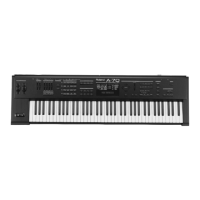
Do you have a question about the Roland A-70 and is the answer not in the manual?
| Number of Keys | 76 |
|---|---|
| Key Type | Semi-Weighted |
| Velocity Sensitivity | Yes |
| Aftertouch | Yes |
| Display | LCD |
| MIDI | In/Out/Thru |
| Controllers | Pitch Bend, Modulation |
| Power | AC adapter |
| Sound Source | None (MIDI controller) |
| Pedal Inputs | 2 (sustain, expression) |
Safety guidelines for power, placement, and environmental conditions.
Instructions for cleaning, handling repairs, and preserving data via backup.
General advice on careful operation, handling controls, and connecting cables.
Guidelines for power connection, avoiding interference, and unit placement.
Procedures for cleaning, handling repairs, and preserving data via memory backup.
General advice for careful operation and avoiding damage to the instrument.
Detailed explanation of the buttons, wheels, sliders, and display on the front panel.
Explanation of the ports for power, MIDI, pedals, and audio outputs on the rear panel.
Step-by-step instructions for connecting cables, devices, and powering the unit on/off.
Explanation of the two primary operating modes and their functional differences.
Guide on using the A-70's zones to control external MIDI devices and channels.
Using the pitch bend lever and modulation wheel for expressive playing.
Instructions for connecting and using the sustain (Hold) pedal.
How to transpose the entire keyboard's pitch by semitones.
How to set individual transposition values for each A-70 zone.
How to set the note range for each zone, enabling keyboard splits.
Overview of the A-70's architecture, zones, controllers, and MIDI output capabilities.
How to turn zones on/off and manage their status for performance.
Accessing context-sensitive help for current displays and parameters.
Using the Panic button to stop stuck notes or reset controllers.
Setting up MIDI IN/OUT connections and routing zone data.
Assigning specific zones to transmit MIDI data through selected MIDI outputs.
How to assign various MIDI functions (CC, Pitch Bend, etc.) to the A-70's controllers.
Fine-tuning modulation depth for individual zones using PALETTE sliders.
Adjusting Aftertouch sensitivity and values for specific zones via Parameter Select.
Configuring Expression (CC11) values for individual zones using Parameter Select.
How to sequence and save sets of Performances as Chains for live performance.
Customizing parameter display and using Name Maps for sound identification.
Using the A-70 to synchronize and control external sequencers via MIDI.
Step-by-step guide for installing optional VE-RD1, VE-GS1, or VE-JV1 boards.
Procedures to initialize the A-70's settings after installing an expansion board.
Instructions on how to play the built-in demo songs.
How to assign names to Performances and Manual settings for identification.
Procedures for saving edited settings to Performance or Manual memories.
Solutions for common problems like no sound, wrong pitch, or connection issues.
Explanations for error messages that may appear during operation.